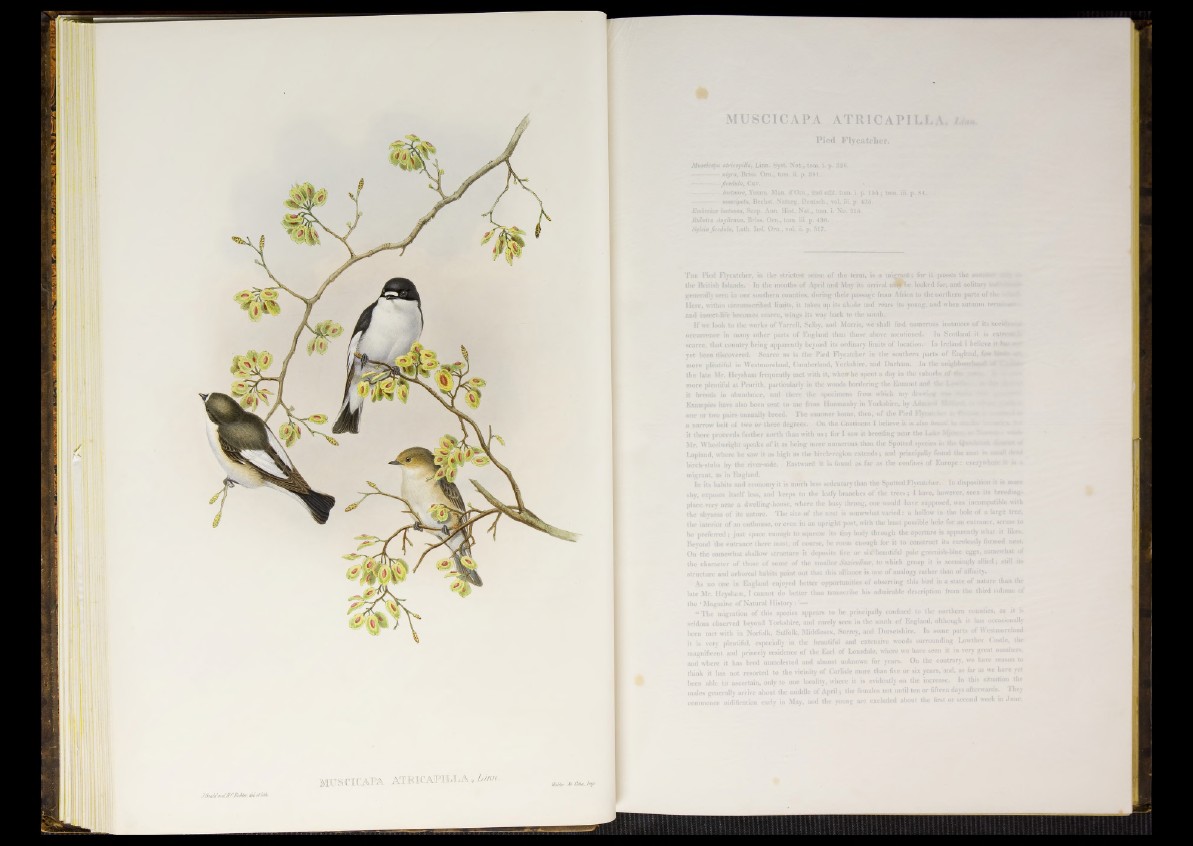
J.GoMmdlf.CSidibr. ¿el M A .
MUSCICAPA « W A H Walter ài Cohn, Imp
MUSCICAPA ATRICAPIL
Pied Flycatcher.
Muscicäpa atricapitta, Linn. Syst. Nat., tom. i. p. 326.
— nigra, Briss. Orn., tom. ü. p. 381.
ßceäula, Cuv.
—— luclmsa, Temm. Man. d’Orn., 2nd edit. tom. i. p. 155 ; tom. iii. p. 84.
— muacipeta. Beeilst. Naturg. Deutsch., vol. in. p. 435.
Emberizo luctuosa, Scop. Ann. Hist. Nat., tom. i. No. 215.
Hubetra Anglicana, Briss. Orn., tom. iii. p. 436.
Sylvia ßcedula, Latli. Ind. Orn., vol. ii. p. 517.
h e Pied Flycatcher, in the strictest sense of the term, is a migrant; for it passes the s««oaner
»e British Islands. In the months of April and May its arrival tnwjr l>c looked for, and solitary ;■ A’
enerally seen in our southern counties, during their passage from Africa to the northern parts of the ■■
lerc, within circumscribed limits, it takes up its abode and rears its young, and when autumn term««
nd insect-life becomes scarce; wings its way back to the soutlu
I f we look to the works of Yarrell, Selby, and Morris, we shall find numerous instances o f its accidi
ccurrence in many other parts o f England than those, above mentioned. In Scotland it is ex tra
earce, that country being apparently beyond its ordinary limits of location* In Ireland I believe it'JhM
et been discovered. Scarce as is the Pied Flycatcher in the southern parts o f England, I r a IdN
»ore plentiful in Westmoreland, Cumberland, Yorkshire, and Durham. In the neighbour!«**! ‘d
lie late Mr. Heysham frequently met with it, wheifhe spent a day in the suburbs of ttaa |
lore plentiful at Penrith, particularly in the woods bordering the Eamont and th# i.
; breeds in abundance, and there the specimens from which my drawwtg w*
Ixamples have also been sent to me from Hunmanby in Yorkshire, by Admir *
ne o r two pairs annually breed. The summer home, then, of the Pied Flycait V
narrow belt o f two o r three degrees. On the Continent I believe it is also Wtw*! »
; there proceeds further north than with u s ; for I saw it breeding near the Lake
Ir. Wheelwright speaks of it as being more numerous than the Spotted species in the kwwfit
.apland, where he saw it as high as the birch-region extends; and principally found the nest in »waM
irch-stubs by the river-side. Eastward it is found as far as the confines of E u ro p e: everywhere it
On the somewhat shallow stru
the character o f those of sons
structure and arboreal habits p
As no one in England enj<
late Mr. Heysham, I cannot d<
the ‘ Magazine of Natural Hist
“ T he migration o f this sp
seldom observed beyond York
been met with in Norfolk, Su
it is very plentiful, especially
br
s sedentary than the Spotted Flycatcher. In disposition it is more
: leafy branches of the trees ; I have, however, seen its breeding-
he busy throng, one would have supposed, was incompatible with
le nest is somewhat varied : a hollow in the bole of a large tree,
upright post, with the least possible hole for an entrance, seems to
;xe its tiny body through the aperture is apparently what it likes.
ie, be room enough for it to construct its carelessly formed nest,
posits five or six beautiful pale greenish-blue eggs, somewhat of
mailer Scucicolinat, to which group it is seemingly allied ; still its
at this alliance is one of analogy rather than of affinity,
opportunities of observing this bird in a state of nature than the
an transcribe his admirable description from the third volume of
think i , not resorted to the vicinity of Carlisle mo
been able to ascertain, only to one locality, where it u
males generally arrive about the middle of April ; the fei
commence nidification early in May, and the yoong a r
e northern counties, as it is
, although it has occasionally
some parts o f Westmoreland
mnding Lowther Castle, the
een it in very great numbers,
: contrary, we have reason to
irs, and, as far as we have yet
crease. In this situation the
fifteen days afterwards. They
first or second week in June.
• the Earl
and
if Lon
and Dot
extensive
ind almost unknown for •